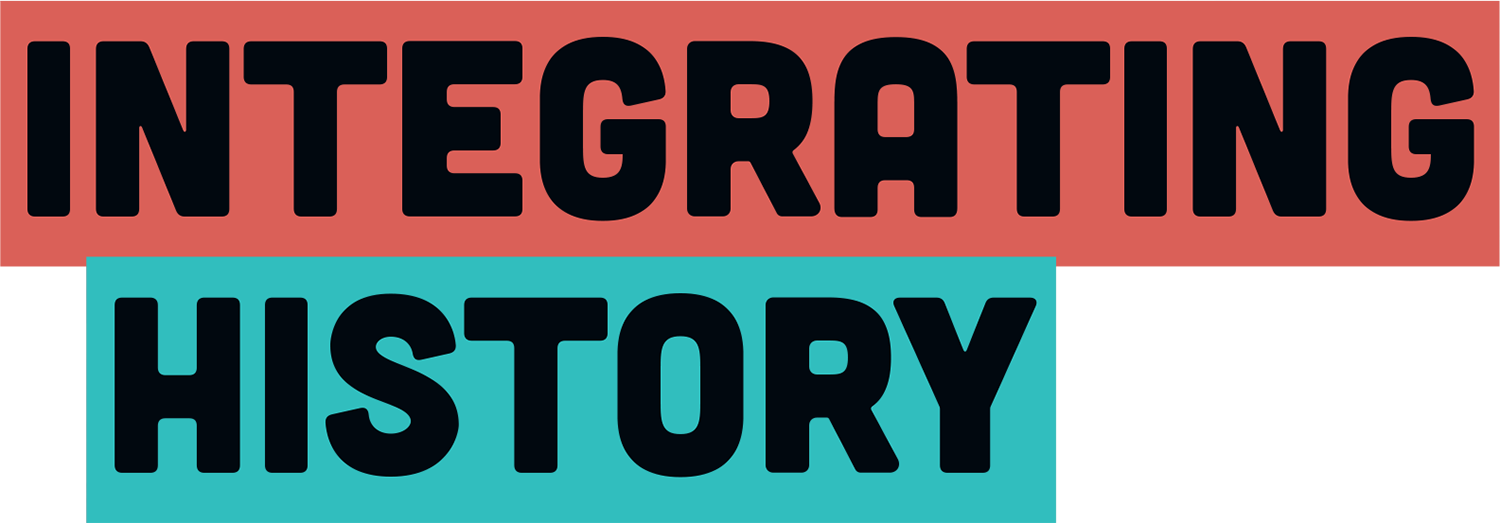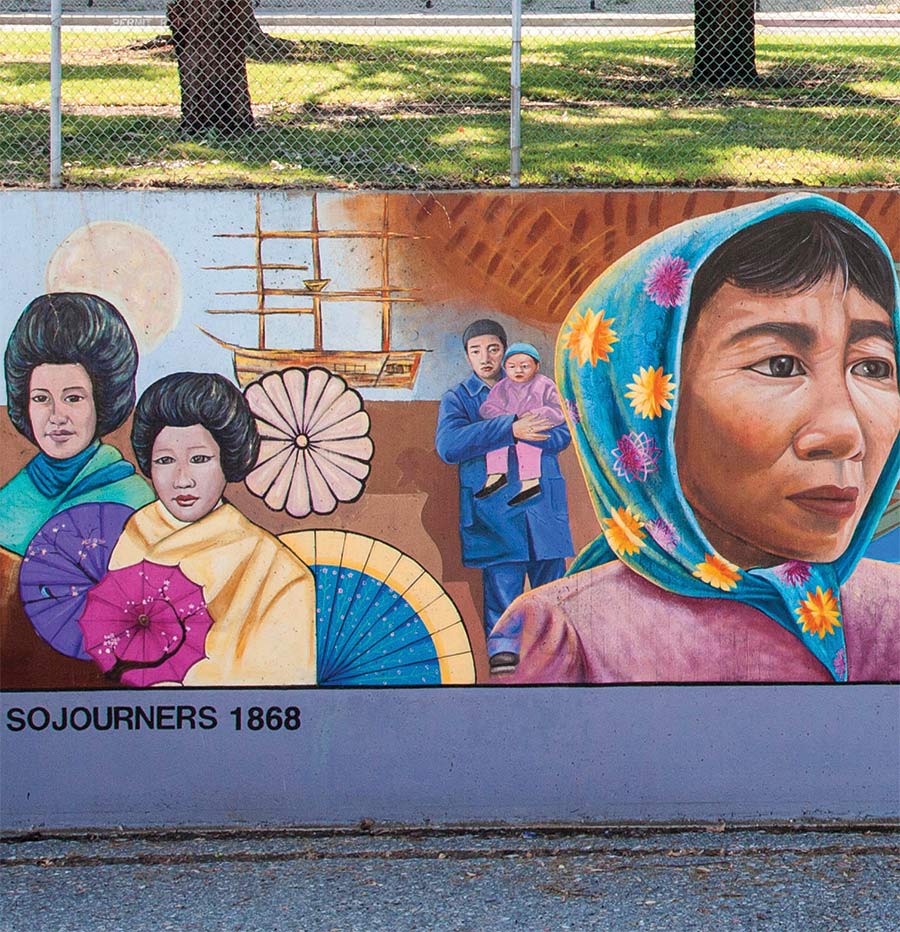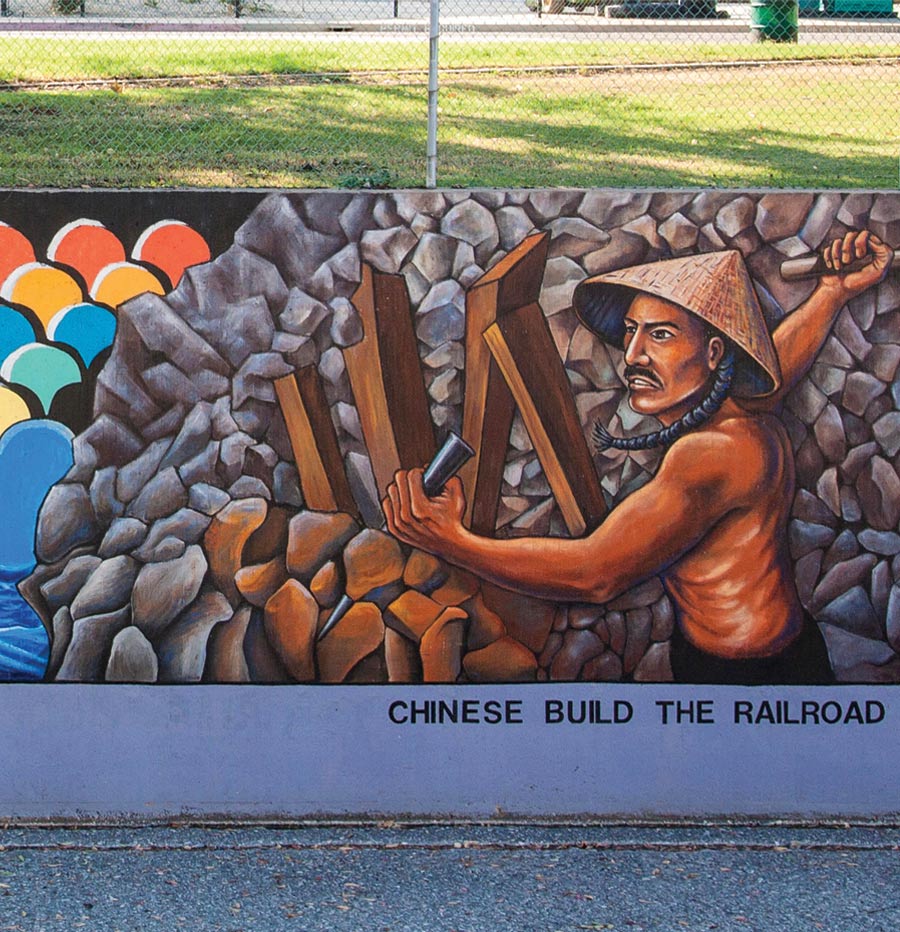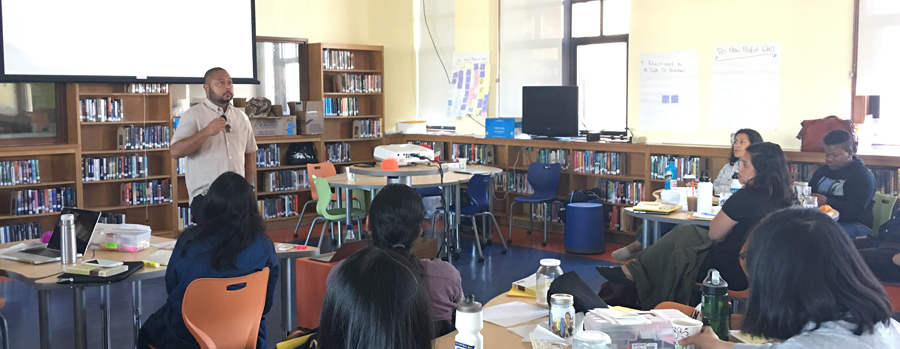
BUILDING SUCCESSFUL ETHNIC STUDIES PROGRAMS
On a cold Sunday this past February, more than 150 Filipina-American college and K-12 educators, their students, families and community converged at Balboa High School in San Francisco. Fondly known as “Bal,” this San Francisco landmark is recognizable for its Spanish Colonial Revival architecture and its former student Jerry Garcia of the Grateful Dead. But on this windy weekend, the Filipino community is here to support up-and-coming musical talent Ruby Ibarra. With her face gracing three billboards in New York City’s Madison Square Garden, Ibarra is a MasterCard-sponsored artist for the “Diversity in Stories” campaign. She appeals to a younger generation, and is someone whom young Filipinas look up to. A Bay Area native, she’s an alumna of the University of California, Davis, and a scientist during her regular work day. The community support is not just for her music. All the women and girls here want to see what’s possible when you have a community behind you, an education and fi erce talent. They are here to see that yes, you can be anything you want. Immigrant from the Philippines? Check. Scientist? Check. Nationally known lyricist? Check.
by Gayle Romasanta

On a cold Sunday this past February, more than 150 Filipina-American college and K-12 educators, their students, families and community converged at Balboa High School in San Francisco. Fondly known as “Bal,” this San Francisco landmark is recognizable for its Spanish Colonial Revival architecture and its former student Jerry Garcia of the Grateful Dead. But on this windy weekend, the Filipino community is here to support up-and-coming musical talent Ruby Ibarra. With her face gracing three billboards in New York City’s Madison Square Garden, Ibarra is a MasterCard-sponsored artist for the “Diversity in Stories” campaign. She appeals to a younger generation, and is someone whom young Filipinas look up to. A Bay Area native, she’s an alumna of the University of California, Davis, and a scientist during her regular work day. The community support is not just for her music. All the women and girls here want to see what’s possible when you have a community behind you, an education and fi erce talent. They are here to see that yes, you can be anything you want. Immigrant from the Philippines? Check. Scientist? Check. Nationally known lyricist? Check.
by Gayle Romasanta

One of the organizers getting these groups and the Filipino Bay Area community to support Ibarra and her musical storytelling is Allyson Tintiangco-Cubales, Ph.D., a San Francisco State University professor. She is the founder of Pin@y Educational Partnerships (PEP) and helped create the curriculum for San Francisco Unified School District’s ethnic studies program.
“We had to go step by step, piecing everything together. We had to create the curriculum because there wasn’t any at that time,” Tintiangco-Cubales said of the early days. “Pretty soon word got out that we were providing services that developed students’ identities, academically challenged them and engaged their participation within their communities.”
Tintiangco-Cubales created PEP in 2001, and it has now grown into a respected teacher-training pipeline that spans kindergarten to doctoral studies, and not only serves the Filipino-American population, but also teachers and students from varied backgrounds.
“PEP was born out of the needs of Filipina/o-American teachers and students in the Excelsior neighborhood of San Francisco,” said Tintiangco-Cubales. As a professor at SFSU, Tintiangco-Cubales’s courses on community development and Filipina/o-American literature emphasize community service learning, and she recruited her students to volunteer in PEP. She explained further in an article for the Asian American Pacific Islander Nexus Journal: “In 2001, the lunch-time youth mentorship program had 11 undergraduate and graduate student mentors from SFSU working with 25 students at Balboa High School … PEP initially emphasized addressing the issues facing the Filipino community … and the lack of Filipina/o-American content in the curriculum.” The program has since “grown its own” educators and provides after-school and lunch-time services at five public schools with over 40 teacher apprentices. Eighteen years later, it is a widely known as a supportive and collaborative teacher pipeline that is active on many levels of the Asian-American community.
The success of the PEP program also served as a foundation for the development and expansion of ethnic studies in San Francisco USD. After 10 years of the PEP mentorship program serving several San Francisco USD school sites, the ethnic studies pilot program launched at five high schools, with Tintiangco-Cubales as the curriculum consultant. Under her guidance, the district and the five teachers at the pilot program schools created an ethnic studies course that targeted incoming freshmen who were at risk of not graduating — students who had a history of poor attendance and grade point average issues in the prior year. The district partnered with Stanford University, and the findings of the pilot program were summarized in the report, “The Causal Effects of Cultural Relevance: Evidence from an Ethnic Studies Curriculum,” by Thomas Dee, Ph.D. and Emily Penner, Ph.D.. The report found that assignment to the district’s pilot ethnic studies course “increased ninth-grade student attendance by 21 percent, GPA by 1.4 grade points and credits earned by 23.” The report concluded that “the course reduced drop-out rates and suggests that culturally relevant teaching, when implemented in a supportive, high-fidelity context can provide effective support for at-risk students.”
In 2014, based on the data and discussion with the Stanford University partnership, the San Francisco USD school board unanimously approved the resolution to institutionalize ethnic studies as a graduation requirement at all of the district’s 19 high schools.
Teacher Support is Community Support
Artnelson Concordia, a teacher on special assignment in the district, currently supports San Francisco USD’s high school ethnic studies teachers. Working from the district office and conducting site visits, he coordinates the roll out and the implementation of ethnic studies classes. Not all ethnic programs at the school sites are the same. Some high schools choose to do wall-to-wall ethnic studies, where all ninth-graders take the ethnic studies course. Other sites have chosen to also create an honors section to make the courses more grade specific and rigorous.
He remembers the beginning of the ethnic studies pilot program, when he was a social studies teacher at Balboa High School working with Tintiangco-Cubales. He recalls how the social studies teachers from the five piloted high schools worked tirelessly developing unit plans that took into account students’ social-emotional learning. “We would meet after school, weekends and release days,” Concordia said. “After going over learning theories, we realized at the beginning of planning that professional development is essential for a social studies-turned-ethnic studies teacher. An ethnic studies program is only as effective as its teacher. We’ve been lucky that our teachers have been moved by the curriculum. They’re relearning too.”
THE CULTURE AND THE CLIMATE OF SUPPORT HAS TO EXIST AT ALL LEVELS AND BUY-IN IS IMPORTANT. I BELIEVE BRINGING TOGETHER SCHOOL LEADERS, CENTRAL OFFICE LEADERS AS WELL AS FAMILIES AND COMMUNITY IS IMPORTANT IN PROVIDING CONTEXT FOR EVERYONE TO UNDERSTAND EDUCATION ABOUT ALL CULTURES IS IMPORTANT. ETHNIC STUDIES DOES NOT TAKE AWAY FROM ANY ASPECTS OF LEARNING, NOR DOES IT DECREASE THE VALUE OF LEARNING TRADITIONAL SUBJECTS, BUT IT, IN FACT, ENHANCES LEARNING FOR EVERYONE.
– Shamann Walton, San Francisco USD board member
Ethnic Studies Legislation
PEP has been instrumental in partnering with SFSU and San Francisco USD to become the main pipeline for Bay Area Filipino-American teacher training. The nonprofit is a fierce advocate for ethnic studies and was also a vocal supporter of Assembly Bill 123, written by Assemblymember Rob Bonta (D-Alameda), the first Filipino-American California State Legislator. Signed into law by Gov. Jerry Brown in 2013, AB 123 requires that the State Board of Education ensures that state curriculum and framework “include instruction in the role of immigrants, including Filipino-Americans in the farm labor movement.”
According to Stephanie Gregson, Ed.D., director of the California Department of Education Curriculum Frameworks & Instructional Resources Division and executive director of the Instructional Quality Commission (IQC), “One of the 10 instructional programs that were approved by the SBE [in July 2017] for K-8 history and social sciences was ‘expanded coverage of the farm labor movement that includes not only Cesar Chavez, but also the role of Filipinos and Filipino civil rights leader Larry Itliong.’”
Assemblymember Bonta authored AB 123 due to the lack of instructional material on Itliong, who co-founded the United Farm Workers with Cesar Chavez, and the erasure of the Filipino-American contribution to the farm labor movement. A history major before attending Yale Law School, Bonta believes in communities seeing themselves in their history books. “It’s really important to see your community’s successes reflected in complete accuracy and truth in the history books that you read,” said Bonta. “That creates that inspiration for the next generation, that confidence, that self-esteem, that belief, the ability to make change, to drive us forward to make progress.”
In 2016, AB 2016 (Alejo, D-Salinas), which mandates that the Instructional Quality Commission create an ethnic studies model curriculum, was passed. The commission will submit the ethnic studies model curriculum to the SBE to adopt on or before March 31, 2020. Districts are encouraged to “offer a standards-based ethnic studies curriculum” based on the model curriculum for grades 9-12.
With two years before the model curriculum is approved, school districts should ideally begin partnering with community stakeholders, colleges and universities, and teachers to get buy-in support for an ethnic studies program now. San Francisco USD board member Shamann Walton, has advice for districts just beginning their ethnic studies journey.
“The culture and the climate of support has to exist at all levels and buy-in is important. I believe bringing together school leaders, central office leaders as well as families and community is important in providing context for everyone to understand education about all cultures is important,” Walton said. “Ethnic studies does not take away from any aspects of learning, nor does it decrease the value of learning traditional subjects, but it, in fact, enhances learning for everyone.”

Summer professional development guest presenter, Dr. Patrick Camangian, University of San Francisco School of Education, Urban Ed and Social Justice (UESJ) talks to SFUSD ethnic studies teachers.
Jose Lara, school board member at El Rancho Unified School District and coordinator for the advocacy group Ethnic Studies Now encourages districts to pass resolutions to begin the work of creating ethnic studies courses. “Pass resolutions to make this happen. Form a committee of teachers and create a unique model that includes the interest and education needs of the community,” Lara said. He was recently appointed to the IQC committee working on the ethnic studies model curriculum.
El Rancho USD, located in Los Angeles County, was the first district in California to adopt ethnic studies as a high school graduation requirement. Currently, El Rancho USD students have the option of taking high school courses such as Multicultural Literature, Mexican American Heritage, Examining Cultural Diversity and Gender in Literature and Film, and Chicano Mural Art. The district also provides tours for schools and districts interested in learning more about their ethnic studies program.
IQC’s Executive Director Gregson agrees that districts should start considering ethnic studies curriculum now. “Districts that are interested in offering ethnic studies courses can begin the process of proposing ethnic studies courses, submitting them for A-G approval, identifying textbooks, encouraging collaboration with ethnic studies teachers at local UCs and CSUs, and creating professional development opportunities for prospective ethnic studies teachers,” she said. “The model curriculum also aims to provide resources to support teachers and administrators.”
PEOPLE THINK YOU’RE REVISING HISTORY TO MAKE STUDENTS FEEL GOOD. BUT WE’RE NOT. WE ARE HISTORY. ETHNIC STUDIES IS HISTORY. IF YOU’RE TEACHING CALIFORNIA HISTORY, IT IS A STORY OF INDIGENOUS CULTURE, SURVIVAL, AND IMMIGRANTS PROVIDING LABOR AND A STORY OF DREAMERS OF ALL GENERATIONS.
– Dawn Mabalon, SFSU professor
For school districts addressing AB 123, they can begin “working to ensure that their textbook offerings are in alignment with the legislation,” explained Gregson. “AB 123 calls for the State Board of Education to ensure the state curriculum, framework and state criteria for selecting textbooks include the contributions of Filipino-Americans in the farm labor movement.”
Communitywide Critical Thinking
Dawn Mabalon, Ph.D., a Stanford-trained historian and an SFSU professor, provides history workshops for PEP and believes ethnic studies supports critical-thinking skills in high school and beyond.
“When students see themselves in their curriculum, they engage because the instructional materials are resonating with them,” said Mabalon. “Critical-thinking, problem-solving, reading, writing about these histories carries with them through the rest of their lives. People think you’re revising history to make students feel good. But we’re not. We are history. Ethnic studies is history. If you’re teaching California history, it is a story of indigenous culture, survival, and immigrants providing labor and a story of dreamers of all generations.”
This collective history is evidenced at Ruby Ibarra’s video shoot on that Sunday afternoon in February. While the more than 150 educators, students, families and community members were there for a rock star in their midst, they were also there to reaffirm their worth and relevance. Older students took turns reading their own poetry to the group, while elementary and middle school students sang songs from the Broadway play Hamilton. They waited patiently to be featured as a strong Pinay, Tagalog for a girl or woman of Filipino descent, in Ibarra’s music video. Some wore traditional Filipino cultural Spanish-style or tribal dresses. A camera woman recorded women and girls answering the question, “What makes you a strong Pinay?”
Tintiangco–Cubales, who has been supporting this ethnic studies work for almost 20 years, understands these are teaching moments for students, educators and for communities who haven’t historically been taught the worth of their culture or culturally relevant pedagogy.
PEP HAS BEEN A PLACE WHERE STUDENTS AND TEACHERS LEARN TO FIND THEIR PURPOSE AND LEARN HOW TO BE EDUCATORS THAT MATTER. IT’S BECOME A STRONG AND DEVELOPED COMMUNITY WHERE NOT ONLY STUDENTS ARE LEARNING ABOUT ETHNIC STUDIES, WE’RE DEVELOPING TEACHERS RESPONSIVE TO STUDENTS.
– Allyson Tintiangco-Cubales, Ph.D., SFSU professor.
“PEP has been a place where students and teachers learn to find their purpose and learn how to be educators that matter. It’s become a strong and developed community where not only students are learning about ethnic studies, we’re developing teachers responsive to students.”
When students begin to learn their history, they are also taught that they can be active, positive contributors to their community. “Students are not just finding out who they are and their history, but they’re learning how to make positive change in their communities, so our young people and their families have a better chance at sustaining themselves,” Tintiangco-Cubales said. “With ethnic studies, populations of students that were traditionally marginalized can feel like they are finally learning who they are. They are finally at the center of the story, contributors to society, part of history and sometimes, like a rock star at their own video shoot. Teachers also feel like they can engage their students with successful results. When a group of people are interested in being critical educators, it’s magical.”
For more information about ethnic studies programs at school districts that are similar to yours, resources and research, visit the following links:
Pin@y Educational Partnerships
Ethnic Studies Study Tour, El Rancho High School, El Rancho USD, contact Assistant Superintendent Jaqueline Cardenas: jcardenas@erusd.org
The Causal Effects of Cultural Relevance: Evidence from an Ethnic Studies Curriculum
Gayle Romasanta is a freelance writer. Her work can be found at www.bridgedelta.com.